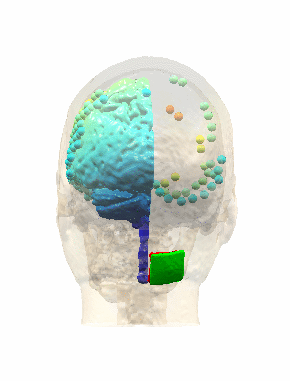Validation of TES models

Collaborating with Dr. Anli Liu and her team at NYU Medical Center, we recorded in vivo intracranial signal under transcranial electrical stimulation, on 10 subjects, with a total of over 1300 intracranial recording electrodes. These data are compared to high-resolution, individual models for each subject which captures significant amount of anatomical detail and also surgical instrument. We showed that the current computational models of TES can well predict the distribution patterns of the electric field in the brain, and over-estimate the absolute magnitudes of the electric field by a factor of 2 if using literature conductivity values. Calibrated models show that the maximal electric field that can be achieved is up to 0.4 V/m under 2 mA stimulation*. Also the recorded data give us guidelines in future modeling work: subject-specific modeling is important, especially in that one needs to include the lower part of the head until the jaw; CSF is needed in the model, otherwise the model will give worse prediction on electric field magnitude; including multiple skull compartments or white matter anisotropy does not seem to improve model accuracy.
Here is the full text of the publication: Y. Huang, A. Liu, et al., Measurements and models of electric fields in the in vivo human brain during transcranial electric stimulation, eLife 2017;6:e18834
Here is an Insight article that briefly talks about the significance of this work.
Here is a video that visualizes the model details, and here is a short talk about this work that I gave at a symposium at Mount Sinai.
To allow other researchers to replicate our results, and test and improve their models, we make the data publicly available here. Note you may need to register at crcns.org and agree to their license to download the data.
*Note: Recently (November 2017) Alex Opitz pointed out a problem in the calibration of the voltage recordings. We had incorrectly interpreted the peak-to-peak amplitude of the stimulator as zero-to-peak. Due to this, all the magnitude values of voltages and electric field in the published paper have to be multiplied by 2. So 2 mA stimulation can lead to an electric field as high as 0.8 V/m, which is now in agreement with previous modeling studies, as well as other in vivo measurements, including the one performed by Alex Opitz. The official Correction Notice is published here.